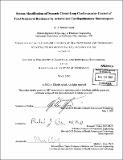| dc.contributor.advisor | Richard J. Cohen. | en_US |
| dc.contributor.author | Aljuri, A. Nikolai (Antony Nikolai), 1968- | en_US |
| dc.contributor.other | Harvard University--MIT Division of Health Sciences and Technology. | en_US |
| dc.date.accessioned | 2006-03-24T18:01:21Z | |
| dc.date.available | 2006-03-24T18:01:21Z | |
| dc.date.copyright | 2002 | en_US |
| dc.date.issued | 2002 | en_US |
| dc.identifier.uri | http://hdl.handle.net/1721.1/29900 | |
| dc.description | Thesis (Ph.D.)--Harvard--Massachusetts Institute of Technology Division of Health Sciences and Technology, 2002. | en_US |
| dc.description | Vita. | en_US |
| dc.description | Includes bibliographical references (leaves 72-76). | en_US |
| dc.description.abstract | Prolonged exposure to microgravity in space flight missions (days) impairs the mechanisms responsible for defense of cardiac output (CO) and arterial blood pressure (Pa) against orthostatic stress during re-entry and in the post-flight period. To date, available countermeasures have not been able to eliminate the observed orthostatic hypotension. The mechanisms responsible for the observed orthostatic intolerance are not yet completely understood. Pa is maintained by control pathways, which influence either total peripheral resistance (Ra) or CO. Central control of Ra is achieved by a complex closed-loop negative feedback system composed of the arterial and the cardiopulmonary baroreflexes. The aims of the doctoral research presented in this thesis were: 1) design and employ a novel conscious animal model for the examination of arterial and cardiopulmonary baroreceptors in the dynamic closed-loop short-term control of Ra. 2) develop and apply a system identification method for the analysis of fluctuations in Pa, right atrial pressure (Pra), and Ra to quantitatively characterize the physiologic mechanisms responsible for the couplings between these variables. For this purpose, eight conscious sheep were used, where both types of baroreceptors were simultaneously exposed to random independent beat pressure variations over a small range around their operating points, while Ra was measured. Subsequently, system identification was applied to determine the quantitative dynamic contributions of Pa and Pra to short-term closed-loop regulation of Ra. To validate the dynamic properties of the transfer function estimates from the developed system identification method, step response estimates from Pa to Ra and from Pra to Ra were compared to directly measured step response observations. | en_US |
| dc.description.statementofresponsibility | by A. Nikolai Aljuri. | en_US |
| dc.format.extent | 77 leaves | en_US |
| dc.format.extent | 3015933 bytes | |
| dc.format.extent | 3015742 bytes | |
| dc.format.mimetype | application/pdf | |
| dc.format.mimetype | application/pdf | |
| dc.language.iso | eng | en_US |
| dc.publisher | Massachusetts Institute of Technology | en_US |
| dc.rights | M.I.T. theses are protected by copyright. They may be viewed from this source for any purpose, but reproduction or distribution in any format is prohibited without written permission. See provided URL for inquiries about permission. | en_US |
| dc.rights.uri | http://dspace.mit.edu/handle/1721.1/7582 | |
| dc.subject | Harvard University--MIT Division of Health Sciences and Technology. | en_US |
| dc.title | System identification of dynamic closed-loop cardiovascular control of total peripheral resistance by arterial and cardiopulmonary baroreceptors | en_US |
| dc.type | Thesis | en_US |
| dc.description.degree | Ph.D. | en_US |
| dc.contributor.department | Harvard University--MIT Division of Health Sciences and Technology | |
| dc.identifier.oclc | 51165849 | en_US |
